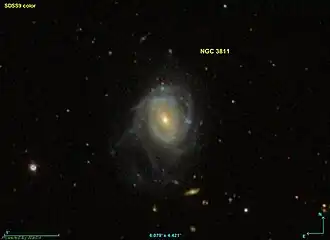NGC 3811
| NGC 3811 | |
|---|---|
 NGC 3811 imaged by SDSS | |
| Observation data (J2000 epoch) | |
| Constellation | Ursa Major |
| Right ascension | 11h 41m 16.6161s[1] |
| Declination | +47° 41′ 26.887″[1] |
| Redshift | 0.010294±0.000009[1] |
| Heliocentric radial velocity | 3,086±3 km/s[1] |
| Distance | 152.10 ± 12.53 Mly (46.633 ± 3.843 Mpc)[1] |
| Apparent magnitude (V) | 12.9[1] |
| Characteristics | |
| Type | SB(r)cd[1] |
| Size | ~110,600 ly (33.91 kpc) (estimated)[1] |
| Apparent size (V) | 2.2′ × 1.7′[1] |
| Other designations | |
| IRAS 11386+4758, UGC 6650, MCG +08-21-091, Mrk 185, PGC 36265, CGCG 242-074[1] | |
NGC 3811 is a barred spiral galaxy in the constellation of Ursa Major. Its velocity with respect to the cosmic microwave background is 3,299±15 km/s, which corresponds to a Hubble distance of 158.7 ± 11.1 Mly (48.65 ± 3.41 Mpc).[1] Additionally, 12 non-redshift measurements give a similar mean distance of 152.10 ± 12.53 Mly (46.633 ± 3.843 Mpc).[2] It was discovered by German-British astronomer William Herschel on 9 February 1788.[3]
NGC 3811 is a starburst galaxy.[1] It is also a galaxy whose nucleus shines in the ultraviolet range, and is thus listed in the Markarian catalogue as Mrk 185.[4]
Supernovae
Two supernovae have been observed in NGC 3811:
- SN 1969C (type unknown, mag. 12) was discovered by Italian astronomer Leonida Rosino (bio-it) on 9 February 1969, and independently by Jankovits on 11 February 1969.[5][6]
- SN 1971K (type unknown, mag. 16.1) was discovered by Russian amateur astronomer Piotr Grigor'evich Kulikovsky on 12 June 1971.[7][8]
See also
References
- ^ a b c d e f g h i j k l "Results for object NGC 3811". NASA/IPAC Extragalactic Database. NASA and Caltech. Retrieved 3 August 2025.
- ^ "Distance Results for NGC 3811". NASA/IPAC EXTRAGALACTIC DATABASE. NASA. Retrieved 3 August 2025.
- ^ Seligman, Courtney. "New General Catalogue Objects: NGC 3811". Celestial Atlas. Retrieved 3 August 2025.
- ^ Markaryan, B. E. (1969). "Galaxies with an ultraviolet continuum. II". Astrofizika. 5: 443. Bibcode:1969Afz.....5..443M.
- ^ Marsden, Brian G. (14 February 1969). "Circular No. 2134". Central Bureau for Astronomical Telegrams. Smithsonian Astrophysical Observatory, IAU. Retrieved 3 August 2025.
- ^ "SN 1969C". Transient Name Server. IAU. Retrieved 3 August 2025.
- ^ Marsden, Brian G. (18 June 1971). "Circular No. 2335". Central Bureau for Astronomical Telegrams. Smithsonian Astrophysical Observatory, IAU. Retrieved 3 August 2025.
- ^ "SN 1971K". Transient Name Server. IAU. Retrieved 3 August 2025.
External links
 Media related to NGC 3811 at Wikimedia Commons
Media related to NGC 3811 at Wikimedia Commons- NGC 3811 on WikiSky: DSS2, SDSS, GALEX, IRAS, Hydrogen α, X-Ray, Astrophoto, Sky Map, Articles and images